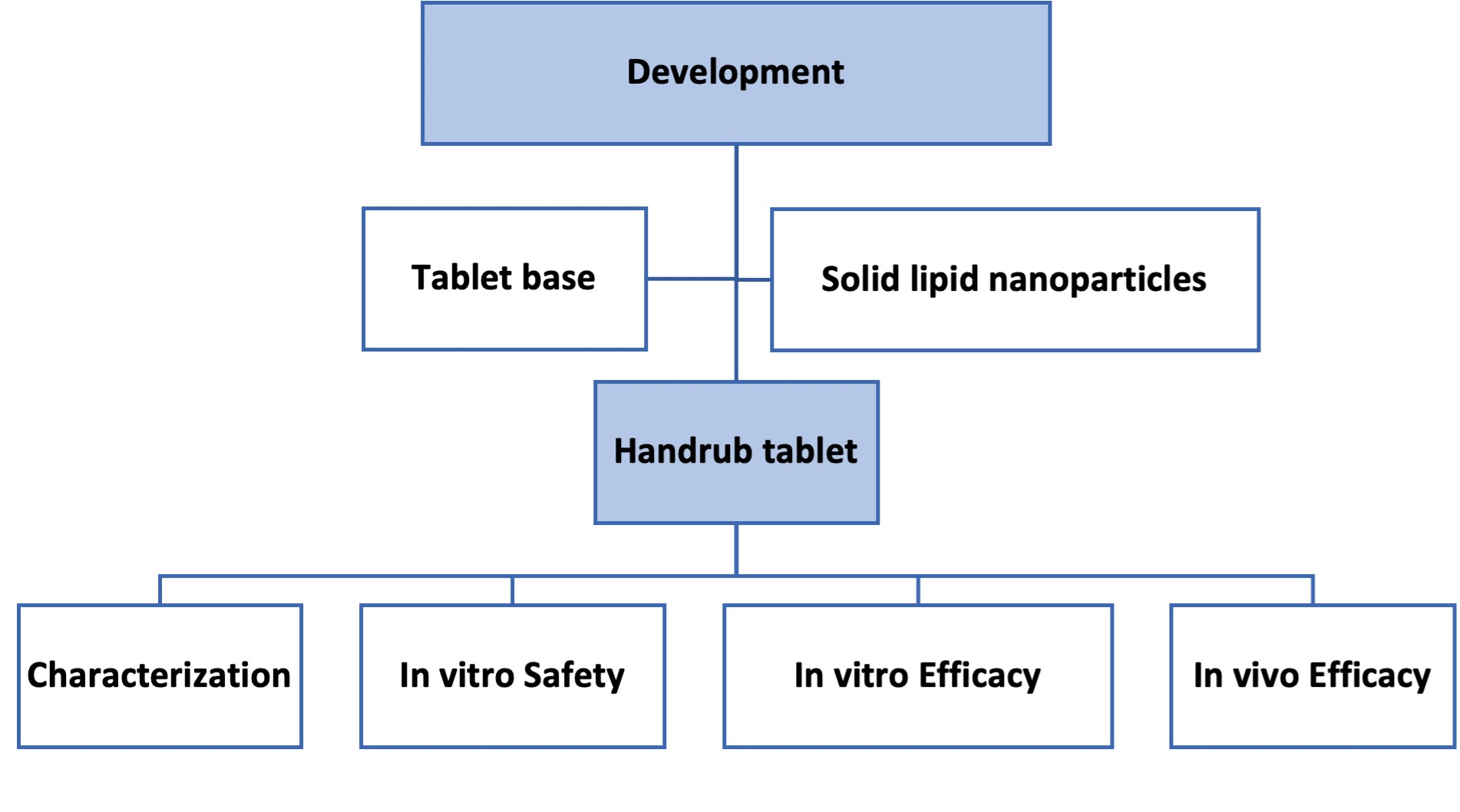A Novel Handrub Tablet Loaded with Pre- and Post-Biotic Solid Lipid Nanoparticles Combining Virucidal Activity and Maintenance of the Skin Barrier and Microbiome

Objective:
This study aimed to develop a holobiont tablet with rapid dispersibility to provide regulation of the microbiota, virucidal activity, and skin barrier protection.
Methods:
A 23 factorial experiment was planned to define the best formulation for the development of the base tablet, using average weight, hardness, dimensions, swelling rate, and disintegration time as parameters to be analyzed. To produce holobiont tablets, the chosen base formulation was fabricated by direct compression of prebiotics, postbiotics, and excipients. The tablets also incorporated solid lipid nanoparticles containing postbiotics that were obtained by high-pressure homogenization and freeze-drying. The in vitro virucidal activity against alpha-coronavirus particles (CCoV-VR809) was determined in VERO cell culture. In vitro analysis, using monolayer cells and human equivalent skin, was performed by rRTq-PCR to determine the expression of interleukins 1, 6, 8, and 17, aquaporin-3, involucrin, filaggrin, FoxO3, and SIRT-1. Antioxidant activity and collagen-1 synthesis were also performed in fibroblast cells. Metagenomic analysis of the skin microbiome was determined in vivo before and after application of the holobiont tablet, during one week of continuous use, and compared to the use of alcohol gel. Samples were analyzed by sequencing the V3–V4 region of the 16S rRNA gene.
Results:
A handrub tablet with rapid dispersibility was developed for topical use and rinse off. After being defined as safe, the virucidal activity was found to be equal to or greater than that of 70% alcohol, with a reduction in interleukins and maintenance or improvement of skin barrier gene markers, in addition to the reestablishment of the skin microbiota after use.
Conclusions:
The holobiont tablets were able to improve the genetic markers related to the skin barrier and also its microbiota, thereby being more favorable for use as a hand sanitizer than 70% alcohol.
1. Introduction
2. Materials and Methods
2.1. Materials
Cetyltrimethylammonium chloride (Sunquart CT-50®), palmitic acid, and stearic acid were purchased from Aqia (Guarulhos, Brazil); poloxamer 188 (Kolliphor® P 188) and polyvinylpyrrolidone K30 (Kollidon 30®) from BASF (São Paulo, Brazil); menthol from Mapric (São Paulo, Brazil); fragrance (Sunflower Fav-310939) from Fav 105 (Diadema, Brazil); silicon dioxide (Aerosil®) from Evonik (São Paulo, Brazil); sodium croscarmellose (Solutab®), magnesium stearate, and microcrystalline cellulose PH101 (Microcel® PH101) from Blanver (Taboão da Serra, Brazil); xylitol, lauric acid, and caprylic acid from Química Anastácio (São Paulo, Brazil); hydroxypropyl cellulose (Klucel TM®) from Ashland (São Paulo, Brazil); and glyceryl monostearate from Labsynth (Diadema, Brazil). Alpha-glucan oligosaccharide, Polymnia sonchifolia root juice, maltodextrin, Lactobacillus (Ecoskin®), and alpha-glucan oligosaccharide (Bioecolia®) were from Solabia (Maringá, Brazil); niacinamide (Niacinamide PC®) from DSM (São Paulo, Brazil); glycyrrhizinate dipotassium from Cosmotec (Guarulhos, Brazil); and valeric acid, butyric acid, and oleic acid from Sigma-Aldrich (São Paulo, Brazil). All the reagents and solvents were analytical grade and were purchased from commercial suppliers.
Download the full study as PDF here: A Novel Handrub Tablet Loaded with Pre- and Post-Biotic Solid Lipid Nanoparticles Combining Virucidal Activity and Maintenance of the Skin Barrier and Microbiome
or read it here
Machado, A.C.H.R.; Marinheiro, L.J.; Benson, H.A.E.; Grice, J.E.; Martins, T.d.S.; Lan, A.; Lopes, P.S.; Andreo-Filho, N.; Leite-Silva, V.R. A Novel Handrub Tablet Loaded with Pre- and Post-Biotic Solid Lipid Nanoparticles Combining Virucidal Activity and Maintenance of the Skin Barrier and Microbiome. Pharmaceutics 2023, 15, 2793.
https://doi.org/10.3390/pharmaceutics15122793

